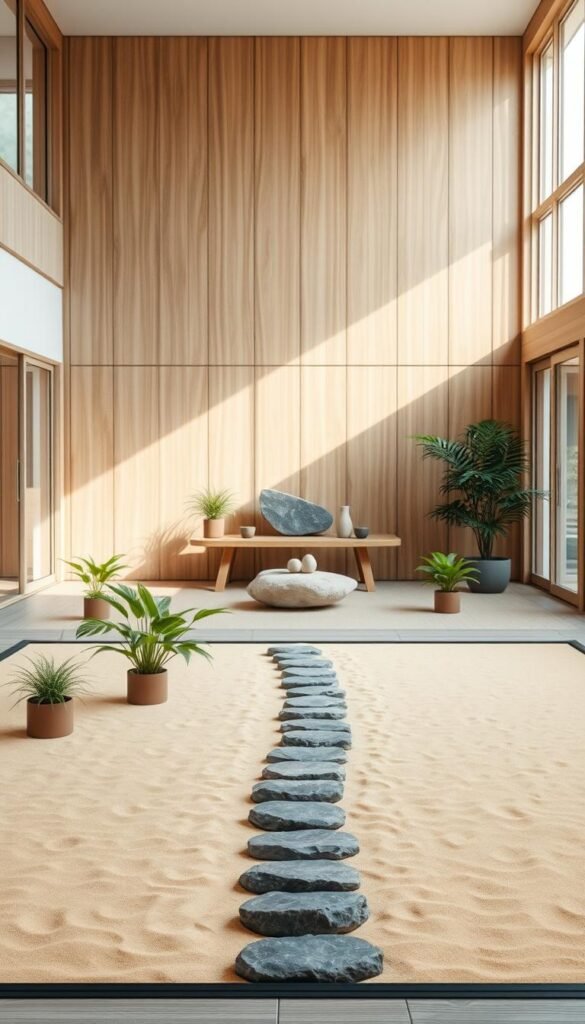Imagine having a serene space that melts stress away while fitting on your desk or shelf. This is the magic of a miniature zen garden – a timeless Japanese tradition reimagined for modern living. These carefully arranged landscapes of sand, stones, and greenery turn any corner into a personal retreat.
Originally called karesansui (“dry-mountain-water”), these designs date back centuries to Buddhist temples. Today’s versions keep their meditative power while adapting to apartments and offices. The rhythmic act of raking sand patterns or tending tiny plants becomes a mindfulness practice you can enjoy daily.
Studies show interacting with natural elements lowers cortisol levels and improves focus. A desktop garden offers these benefits without needing backyard space. Whether you choose polished pebbles or a bonsai accent, each element invites you to pause and breathe deeply.
Best part? You don’t need special skills to start. Even five minutes arranging stones can create tranquility during a hectic day. This isn’t just décor – it’s a toolkit for finding calm wherever you live.
Discovering the Benefits of an Indoor Zen Garden
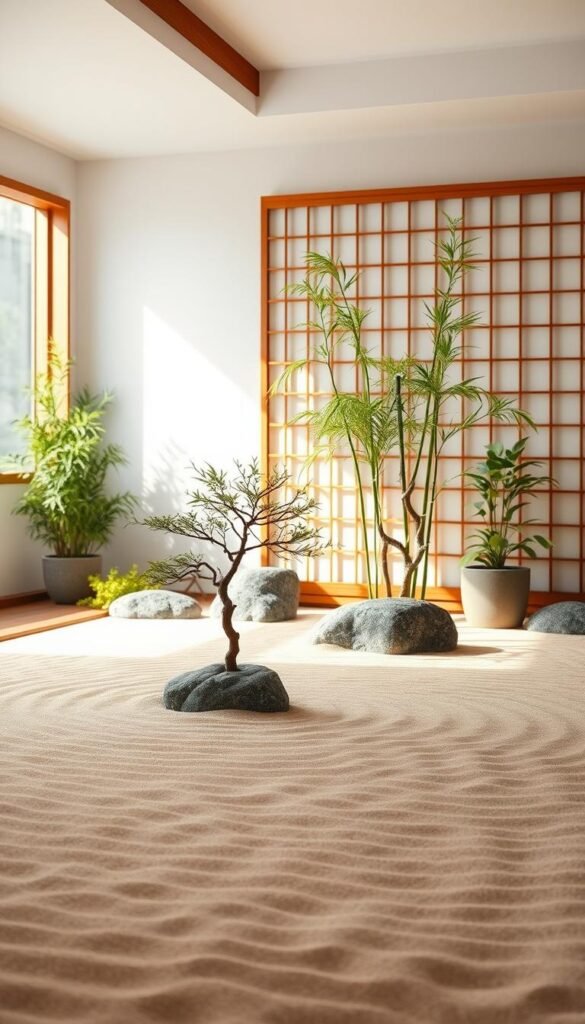
Ever notice how stepping into a quiet space instantly lifts your mood? That’s the power of creating a miniature oasis at home. These compact landscapes do more than look pretty—they rewire how you engage with your surroundings.
Enhancing Mindfulness and Reducing Stress
Raking swirls into sand or positioning stones isn’t just play—it’s active meditation. Studies reveal tactile activities with natural elements lower heart rates by 11% on average. Your hands become tools to quiet mental chatter, letting you anchor in the present.
One user shared:
“After ten minutes arranging pebbles, I solve work problems faster. It’s like hitting a reset button.”
Integrating Nature into Your Home
You don’t need a backyard to harness nature’s calm. A small tray of sand and rocks taps into our biological need for green spaces. Pair it with air-purifying moss or a succulent arrangement to elevate your space’s energy.
- Sand patterns mimic water ripples, triggering relaxation
- Smooth stones offer grounding textures during anxiety spikes
- Miniature rakes become tools for creative flow
This isn’t about perfection—it’s about building a ritual that reminds you to breathe. Your garden becomes a teacher, showing how simplicity cultivates resilience in chaotic times.
Choosing and Preparing Your Ideal Space
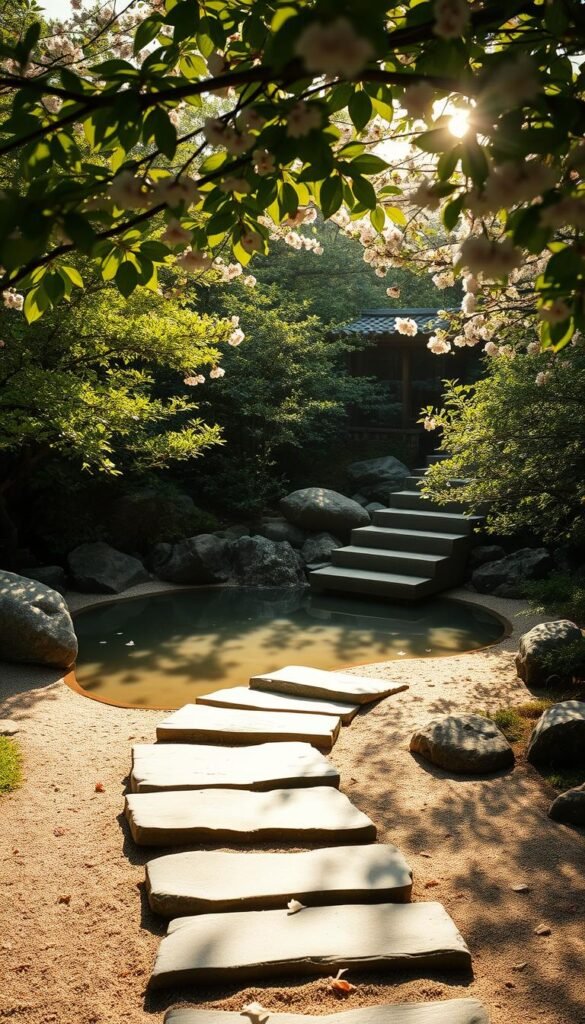
Your home holds hidden pockets of peace waiting to be transformed. The right space becomes more than a location—it shapes how you experience calm. Let’s explore how to create harmony between your environment and intentions.
Finding the Perfect Spot with Natural Light
Morning sunlight streaming through windows does double duty. It nourishes plants while boosting your zen garden’s serene atmosphere. Aim for areas that get 4-6 hours of indirect light daily, like east-facing windowsills or bright kitchen counters.
Listen carefully when scouting locations. A quiet corner away from TVs or foot traffic helps maintain focus. One designer notes:
“Airflow matters as much as visuals—stagnant spaces feel heavy, while breezy spots energize.”
Creating a Calm Atmosphere with Thoughtful Design
Your design choices should whisper, not shout. Earthy tones like slate gray or warm beige blend seamlessly with most decor. If your room has bold wall colors, use neutral stones and sand to balance the energy.
Consider these elements for cohesive styling:
- Wooden trays that complement floor tones
- LED strip lighting with dimmers for evening use
- Felt coasters under miniature rakes to protect surfaces
Clear the chosen spot completely before arranging your garden. This blank canvas approach helps you build intentionality from the ground up. Remember—every choice should invite you to pause and breathe deeper.
Indoor Zen Garden: Bringing Relaxation and Mindfulness into Your Home
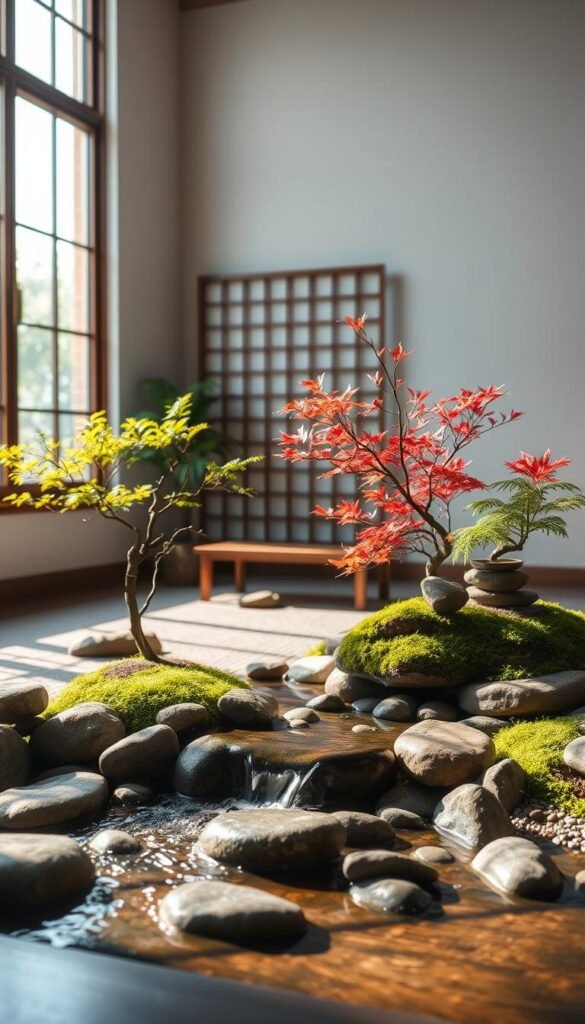
Crafting your personal oasis starts with three fundamental components that work in harmony. Each element serves both practical and symbolic purposes, transforming ordinary items into tools for calm.
Key Elements: Sand, Stones, and Plants
Fine white sand acts as your creative canvas. Specialized options like Jurassic riverbed sand hold intricate patterns better than regular varieties. One gardener notes:
“Raking swirls into purple garnet sand feels like painting with nature’s brush.”
Smooth stones anchor your design. Look for rounded river rocks that fit comfortably in your palm—their weight and texture become grounding points during meditation.
Picking Materials That Inspire Simplicity and Beauty
Low-maintenance plants thrive in these spaces. Snake plants clean air while needing minimal light. Succulents add pops of color without demanding constant care. For sensory depth, try fragrant lavender sprigs tucked between rocks.
Choose materials honoring traditional aesthetics:
- Unpolished clay pots over glossy ceramics
- Natural jute mats instead of synthetic rugs
- Driftwood pieces with weathered textures
Incorporating Natural Decor and Lighting Options
Soft lighting elevates your garden’s mood. Dimmable LED strips cast warm glows on sand patterns at night. Morning sunlight through sheer curtains highlights stones’ natural veins.
Add depth with living moss patches between rocks. They introduce vibrant green tones while improving air quality. Remember—every element should invite quiet reflection, not clutter.
DIY Steps to Build Your Zen Garden
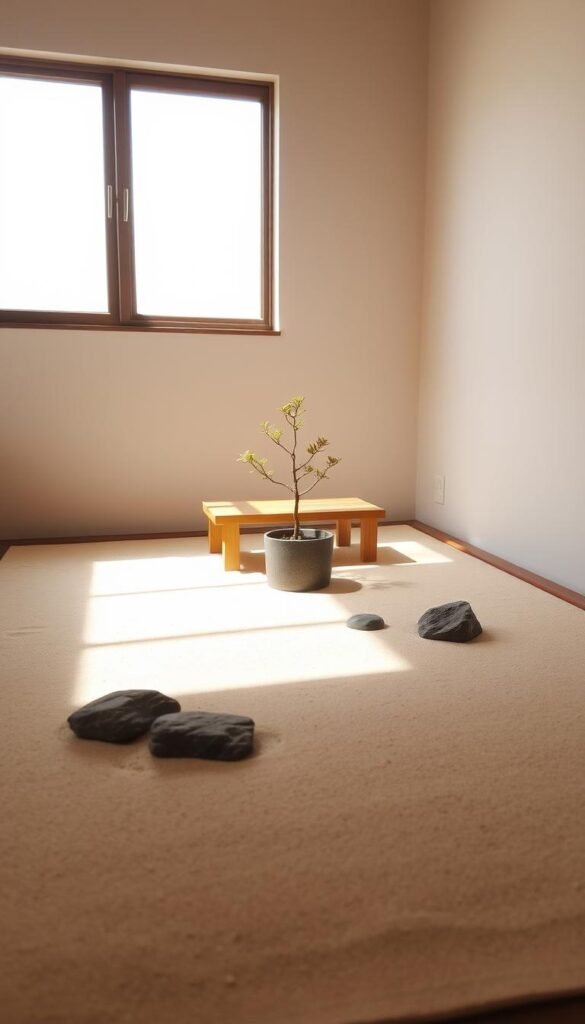
Building your personal sanctuary begins with practical creativity. This hands-on process lets you shape calm through intentional design choices. Let’s transform basic materials into a living meditation tool.
Gathering Essential Materials and Tools
Start with a shallow container – ceramic bowls or wooden trays work beautifully. Choose fine-grain white sand that holds intricate swirls. Add smooth river stones and compact plants like jade or air plants.
One enthusiast shares:
“My thrift-store teacup became the perfect miniature zen space – proof that beauty lives in simplicity.”
Setting Up the Base and Arranging Elements
Fill your chosen vessel two-thirds full with sand. Create gentle slopes using a spoon – these natural curves guide eye movement. Position your largest stone first, then cluster smaller ones around it. Leave open spaces for patterns.
For greenery:
- Nestle succulent roots in sand pockets
- Use moss patches as living carpets
- Angle trailing plants over container edges
Using Zen Tools to Create Raked Patterns
Traditional bamboo rakes make satisfying lines, but chopsticks work too. Try concentric circles for morning focus sessions or parallel waves before bed. A landscape designer suggests:
“Change your patterns weekly – it keeps the practice fresh.”
Remember – your garden evolves with you. Shift elements whenever you need renewed perspective. This isn’t about permanence, but finding peace in the creative process.
Embracing Zen: Final Touches for a Tranquil Home Retreat
Your personal sanctuary becomes complete through thoughtful care and sensory details. A consistent maintenance routine keeps your space vibrant – wipe sand dust weekly and rotate plants toward light sources. Check soil moisture every three days using your fingertip, watering only when dry to the touch.
Refresh your landscape seasonally. Swap autumn maple leaves for winter pinecones, or add blooming jasmine in spring. These subtle shifts mirror nature’s rhythm, deepening your connection to life’s cycles.
Soft lighting transforms evenings. Try amber LED strips beneath stones to cast warm glows on raked patterns. Pair with lavender oil in a diffuser – studies show its scent lowers stress hormones by 24%.
Consider adding a miniature water feature. Tabletop fountains create soothing sounds without clutter. One user reports: “The trickling water helps me unwind faster than silence alone.”
Your creation now serves dual purposes – a meditation tool and living decor. Each choice, from stone placement to scent selection, builds an atmosphere where peace grows naturally. This evolving space becomes your daily reminder: tranquility starts with intentional moments.

